K.M. Alexander's Blog, page 3
October 5, 2024
Uly Pupdate, Autumn 2024
This has been a long and strange year. Through all the ups and downs, one of the constant highlights has been our newest family member, our sheepadoodle, Ulysses. I introduced him back in May, and then our chaotic 2024 summer happened. As autumn settles in and things have quieted down, I realized last night that it has been far too long since I shared a Uly update—or a pupdate. Let’s rectify that!
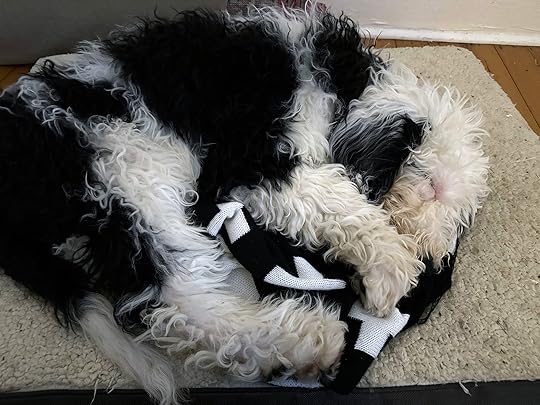

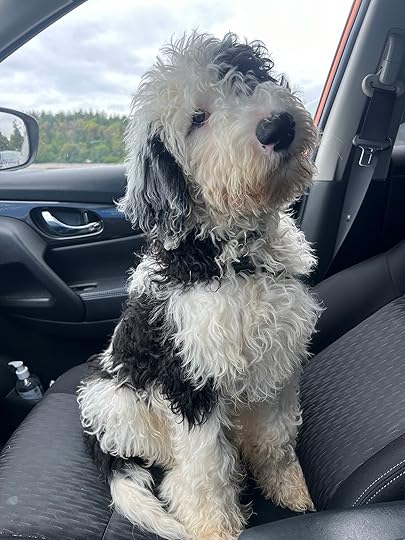
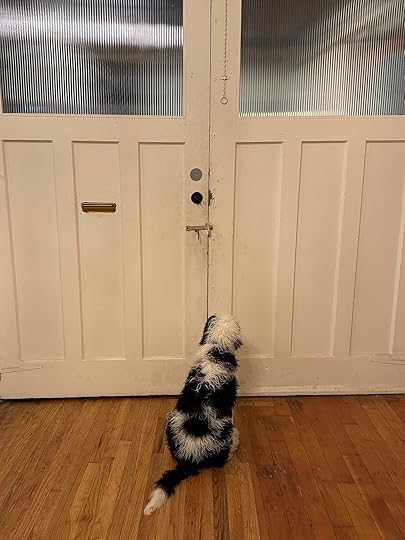
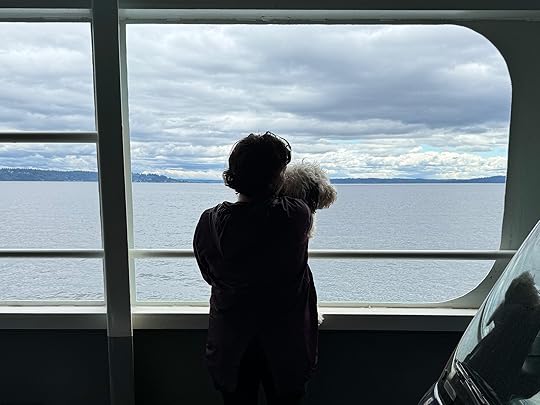
Uly is now seven months old, smart as a whip, and perpetually silly. He’s learned a lot and has doubled in size, but he doesn’t understand how big he’s gotten. We’re still working through typical puppy issues (not listening) and big-dog puppy issues (counter-surfing). But he’s getting better and better. He’s gotten good with a leash. He loves “helping” in the garden, and he’s discovered a love of fruit. (Figs in particular.) He’s figuring it out but very much entering his teenage years. It’s challenging at times, but overall pretty dang fun, puppy energy is a needed addition around here. You can click on each picture for more details.
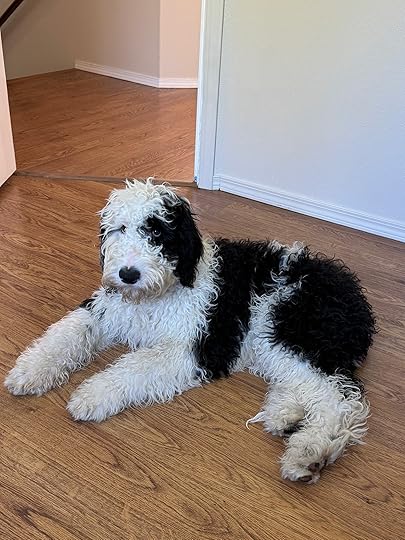



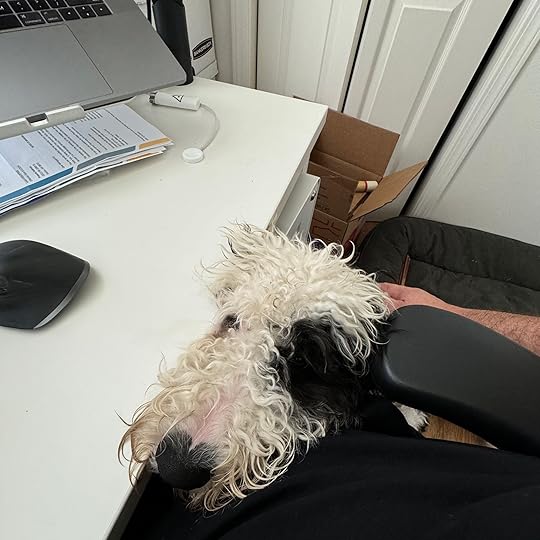

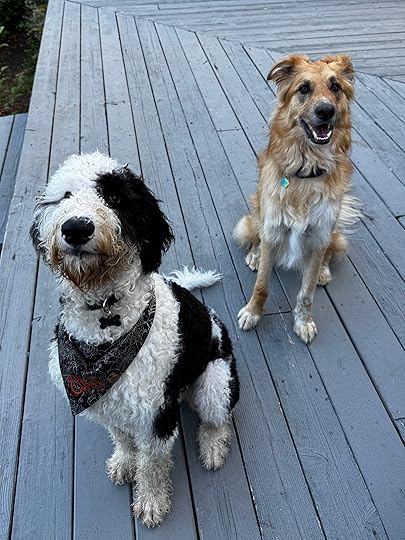
This has been your Autumn 2024 Uly pupdate. I hope you enjoyed it. More to come in the future. Onward!
September 30, 2024
Everything’s A Cover
There’s a rock I keep seeing many science fiction and fantasy fans crash against: adaptation. For some reason, fans think any adaptation must fit within the narrow confines of their own experience. Any new announcement of a beloved property is met with equal parts excitement and trepidation—from soundtracks to cast lists, fans’ grievances over creative decisions are long, exhausting, and arduous—and honestly, the longer I spend in fandom, the more backward this approach feels.
If you engage with science fiction and fantasy you’ll see this play out regularly. In 2001, I remember conversing with a guy who was incensed that Tom Bombidil was not included in Peter Jackson’s adaption of The Fellowship of the Ring. I once watched as a dude completely missed the point of Verhoeven’s Starship Troopers because it didn’t align with his rigid conception presented in the Heinlein novel. Don’t even get me started with people’s thoughts on the casting of Death in Sandman, or that the alien doctor in Dr. Who regenerated into a doctor of a different gender, or whatever Star Wars fans are currently mad about. From casting choices to effects to costume design, it’s nearly impossible to see someone adapt a property from one medium to another without watching a part of fandom stir up into a frothing rage.
I don’t know where or when this sense of entitlement emerged. The pits of fandom are deep and complex. However, the preciousness to which many fans treat their favorite properties often borders on the absurd. We need a reset, and I don’t know how to cause that reset to happen. Even when creators get involved—supporting choices some fans dislike—it doesn’t satiate the outrage engine. (There’s a broader conversation to be had here about our parasocial obsession with pop culture—but this is a blog, and I’m going to keep this narrow.)
 Leonardo da Vinci’s
Salvator Mundi
was often copied by his pupils.
Leonardo da Vinci’s
Salvator Mundi
was often copied by his pupils.Earlier this year, I went to Punchdrunk’s Sleep No More at the McKittrick Hotel in New York City. Coming away, I was struck that it was one of my life’s best theater—heck, entertainment—experiences. If you’re unfamiliar, the show is an adaptation of William Shakespeare’s Macbeth. The audience (forbidden to speak) moves through the sets as the performance happens around them. Unlike Macbeth, Sleep No More was set in a run-down hotel in the 1930s; unlike Macbeth, it featured a diverse cast; unlike Macbeth, it wove in other stories to enrich its setting, characters, and the motives of the principles. Walking away from it, I wondered how Shakespeare purists would take its modifications, and almost immediately after, I chuckled at the thought of a “Shakespeare purist.” It’s rare to see a Shakespeare production that doesn’t modify the source material to fit a different vision—rarer still to see someone complain that a man didn’t play Juliet. Often, noticing those differences is part of the enjoyment of Shakespeare. The adaptation is part of the fun. We see this even stronger in the sphere of music.
Occasionally, the DJs at KEXP (my favorite local radio station) will go off on a tangent of cover songs. Be it a single set or an entire session, they’ll spend some time playing a lot of covers. I love it when this happens. It’s fascinating to hear someone bring something new, put their spin on a beloved track, and recreate the original material in a new and unique way. I’m not alone. We love them, and it shows in our entertainment. Covers set the tone for commercials; they are performed at award shows, crop up in movie trailers, and often appear in soundtracks. Musicians will even create remixes, essentially covers of their own songs, adding a new spin to a popular track.
Are they all a hit? No. Is that failure a reflection on the originals? Again, no. Not at all! Frequently, when a cover song fails, it only props up the greatness of the piece it’s covering. Listeners don’t feel slighted when a cover doesn’t meet their expectations. No one rushes to the internet to post how the cover didn’t “capture the spirit” associated with the original. We don’t even think of the covers in the same light. Do any of the four-hundred twenty-two covers of The Beatles’ “Yesterday” matter in regard to the original track? Of course not.
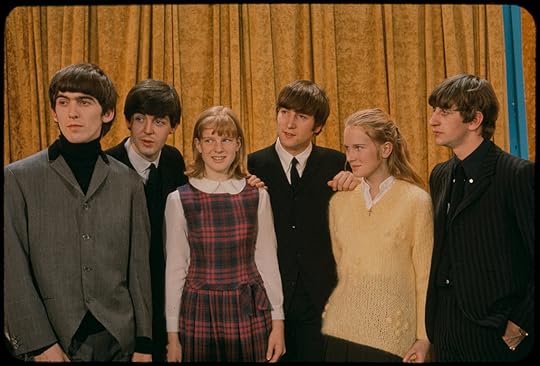 The Beatles with fans on the Ed Sullivan Show, 1964. There are 422 covers of their song “Yesterday.”
The Beatles with fans on the Ed Sullivan Show, 1964. There are 422 covers of their song “Yesterday.”That approach should apply to everything. Nothing adapted—or covered or remixed or whatever—is a reflection of the original, no matter what the keyboard warriors will tell you. A new adaptation cannot ruin one’s original experience with a property. Your experience still exists! It’s still valid! If you don’t like the new cover, you can play the old hits anytime you want. Roddenberry’s Star Trek hasn’t gone anywhere. Hans Christian Andersen’s The Little Mermaid has been adapted many times, and across such a variety of styles, there’s probably a version out there for every taste. The same goes for English folklore’s Robin Hood, Doyle’s Sherlock Holmes, Fleming’s James Bond, and Newman, Webber, and Wilson’s Dr. Who. Heck, there have been over fifty film adaptations of Robert Louis Stevenson’s Treasure Island and if you aren’t interested in film, the book still exists!
And that’s the thing! We should be encouraging more of that, not less. The wilder, the better. Make it weird. Take it to new and unexpected places. Make a cast list with actors who look nothing like the original. Set a scene to unconventional music. Make the original villain the hero. Change the time period. Heck, change history! Who wants to see the same thing remade the same way over and over and over? If we’re not going to seek out original material—and it’s clear consumers love covers—we should at least want the adaptation to take the set pieces in new and original directions. Francis Lawrence’s 2005 Constantine is a fantastic film—one of my favorites—and it’s nothing like my beloved Hellblazer. But it’s a wonderful cover, and the world is better off that they both exist.
It’s okay to say, “Hey, this isn’t for me,” or “I like the last movie more,” or “I liked the book better.” Criticism is a part of creation; it helps others find new favorites and can aid artists in improving their work. Not every adaptation is going to strike a tone that works for every consumer. But that doesn’t mean people shouldn’t try something new and bring their unique voice to a beloved property. Yes, even your favorite beloved property. Other fans might find value where you didn’t. It might build a wider audience and open up the possibility of more.
If anything that cover—successful or not—validates your love. Someone else loved it too, and they loved it enough to put all their time, blood, sweat, and tears into adapting it in a new and unique direction. Its very existence is a homage. And that’s the point. That’s what I wish the broader fandoms understand. No matter how weird, wretched, or wonderful, every adaptation, every cover only serves to make the original all the more special.

Want to stay in touch with me? Sign up for Dead Drop, my rare and elusive newsletter. Subscribers get news, previews, and notices on my books before anyone else delivered directly to their inbox. I work hard to ensure it’s not spammy and contains interesting and relevant information. Sign Up Today →
August 29, 2024
Well, This is Obnoxious
A funny thing happened when I shared Hogenburg—my latest brush set—on Instagram the other day. Instagram, in all its divine authority, added a little tag at the top where you’d typically see location information. That tag read: “AI info.”
 Neat. Thanks, Zuckerberg.
Neat. Thanks, Zuckerberg.I thought that odd. IG now lets you flag if AI was used in a post. But I didn’t use AI, so there was no reason I would flag this post. So, I tapped the tag. When tapped, it brought up this “helpful” little tooltip.
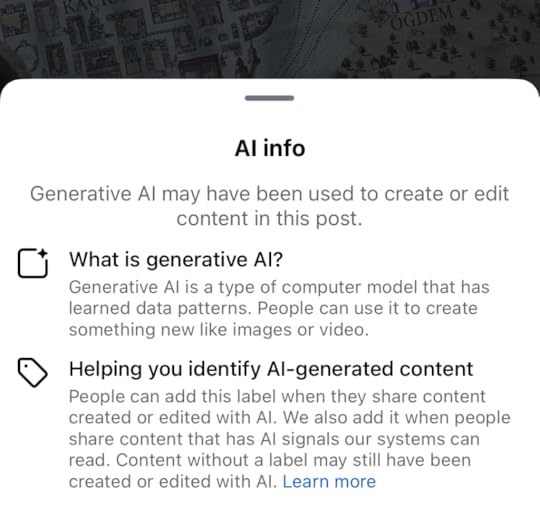 Oh. Cool.
Oh. Cool. 
There is no way to dispute that label.
The obnoxious thing about this is that I didn’t use Generative AI to create or edit content in this post. It was all done by me. I would never use AI generation. Period. AI generation is the antithesis of #NoBadMaps. The goal has always been to preserve the hand-made history inherent to cartography by empowering people to create period-authentic maps by hand.
I will not discuss the ethics of AI in this post, nor will I discuss how I find it soulless. I won’t even go into the fact that Kari-Lise and many of our friends’ work was illegally stolen to use as training data. There are plenty of people discussing all of that already. If anything, this makes me want to use Instagram even less. I put hours into these projects. Is my next Old Haunt going to get flagged? The next photo of Ulysses I color correct in Photoshop?
I am really proud of Hogenburg and happy with my sample map. It’s a perfect example of what you can do with a little effort. As I said in the post for the set, urban maps are more advanced toolsets. They require a lot of subtle finessing to achieve authentic results. Something AI is horrendous at.
In the social media race-to-the-bottom, Instagram already has a problem with crappy AI-generated content. I am sure some of this was an attempt to thwart that garbage. But, it does them no favors to group those of us who put in the time to make original content with the ones producing trash. What’s the incentive for us?
It’s funny. Here, Instagram warns its users about the possible use of AI while actively developing the very tools it feels the need to caution against. Their house is burning, and they’re the ones stoking the flames.
August 27, 2024
Hogenburg: A Free 16th Century Urban Cartography Brush Set for Fantasy City Maps
Mapping a city, fantastical or otherwise, can be a difficult challenge. Nature’s randomness and organic qualities are replaced by a rigid structure influenced by centuries of history shaped by war, religion, politics, and culture. No two roads are the same, no grid is identical, and no block looks like another block. In modern maps, we’ve abstracted the city into patterns, making each city feel familiar from the map’s perspective, even if they’re remarkably different.
Historical cartographers also endeavored to do the same, and we can see a similar inference at work in the brushes in today’s set. It’s been a while since I’ve released any free tools, and I’m excited to announce the release of my latest free urban cartography brush set, Hogenburg.
All my Map Tools will always be free. Want to help support this work?
Click here to learn how.
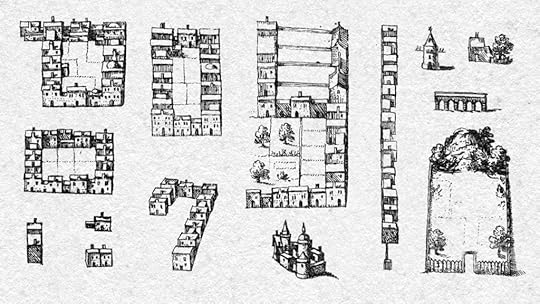 A sample of the blocks and buildings you’ll find in Hogenburg
A sample of the blocks and buildings you’ll find in HogenburgNamed after Frans Hogenburg, a prolific 16th-century Flemish and German copper etcher and engraver. This set comes from the upper and lower sheets of Ierusalem, a depiction of 16th-century Jerusalem taken from Volume IV of Civitates Orbis Terrarum. Savvy readers will recognize that name as four prints from other volumes served as the basis for my Braun set. Like that earlier set, the brushes here try to encapsulate a historical city in an abstraction of blocks, streets, and walls interposed with points of interest and significant buildings, and it achieves a lot! But there’s more at work here than buildings, roads, and walls.
 Some of the unique buildings within the set
Some of the unique buildings within the setHogenburg worked closely with Georg Braun on the Civitates Orbis Terrarum until his death in 1590. He engraved most of the illustrations in Volume I–IV, and Braun, a Catholic cleric, served as the project’s principal, writing and editing the work. Interestingly, Hogenburg had been kicked out of Antwerp by the Duke of Alba because, as a protestant, he had printed engravings in support of the Great Iconoclasm. Yet somehow, these two were able to come together, set aside their differences, and create one of the most important atlases of the Renaissance. There’s a lesson there.
Anyway, Braun’s knowledge of church doctrine is apparent. The map is chock full of small vignettes of Biblical stories from the Old and New Testaments. They add a lot to the map and remind me of the cartouches you find in my Blaeu set. I meticulously disassembled each of these, resulting in many individual brushes of soldiers, kings, dead guys, prophets, saints, random individuals, and small groups. These should allow you to assemble unique scenes that fit within the lore of your projects.
 Just a fraction of the walls and figures included in Hogenburg
Just a fraction of the walls and figures included in HogenburgMy Urban sets are more advanced than my standard cartography sets. It takes a bit to get the right results. That rigid nature intrinsic to a city’s growth requires a little more finessing. Don’t be afraid to disassemble brushes if they don’t perfectly fit your vision. With a bit of work, you can make some lovely maps. Lucky for you, there’s lots to work with, with over 700 brushes; inside Hogenburg, you’ll find:
24 Blocks12 Open Blocks29 Unique Blocks12 Individual Buildings20 Groups of Buildings19 Horiz. Building Rows15 Vert. Building Rows50 Unique Buildings7 Castles9 Sepulcures8 Monuments4 Shrines4 Fences6 Short Walls40 Vertical Walls10 Vertical Gates40 Horizontal Walls21 Horizontal Gates20 Towerless Walls5 Towers (No Walls)6 Gates (No Walls)3 Corner Walls14 Unique Walls17 Fountains9 Bridges7 Stairs5 Bushes110 Individual Trees7 Forests15 Unique Trees15 Animals8 Angels8 Dead Guys5 Tortured People8 Soldiers47 Individuals8 Pairs of People16 Crowds27 Objects6 Rocks4 Caves6 Ponds14 SymbolsThe button below links to a ZIP file that contains an 8.5 MB Photoshop ABR brush set (it’ll also work with GIMP, Affinity Photo, and I’m told Procreate now). I also release the set as a pack of individual PNGs organized by folder, similar to how I organize the ABR file. This should make using these with tools like Wonderdraft much easier. No more extracting symbols from an enormous PNG. There’s also a little bonus down below the example maps.
Like this set? Click here to learn how you can support this project.
DOWNLOAD HogenbergDownload the Hogenberg PNG Pack
(9.4 MB)
As with all of my previous brush sets, Hogenberg is free for any use. I distribute my sets with a Creative Common, No Rights Reserved License (CC0), which means you can freely use this and any of my brushes in personal or commercial work and distribute adaptations. No attribution is required. Easy peasy!
Enjoy Hogenberg? Feel free to show me what you created by emailing me. I love seeing how these brushes get used, and I’d be happy to share your work with my readers. Let me see what you make!
Hogenberg in UseWant to see how I’ve used this set? There are three versions: a colored example, a black-and-white rendition, and a decorated sample. Click on any of the images below to view them larger. Perhaps this will inspire you as you get started on your projects!
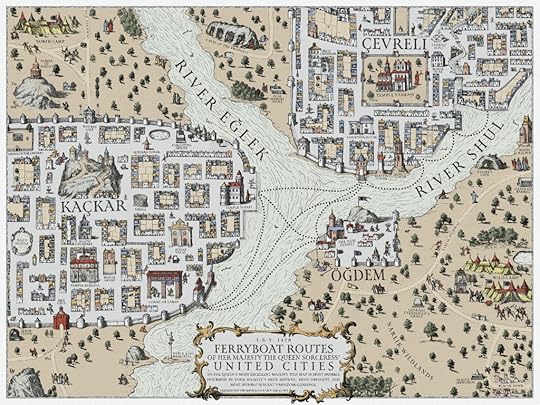 4000×5000 (12.5 MB)
4000×5000 (12.5 MB)
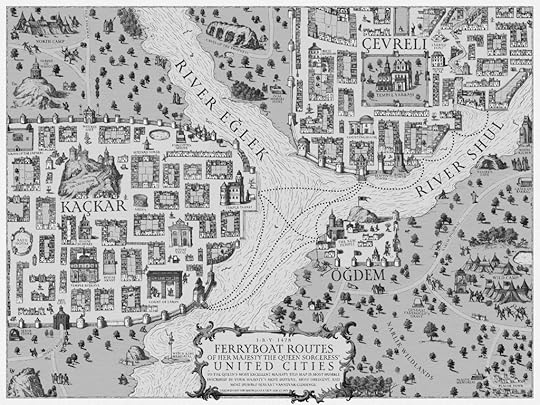 4000×5000 (8.7 MB)
4000×5000 (8.7 MB)
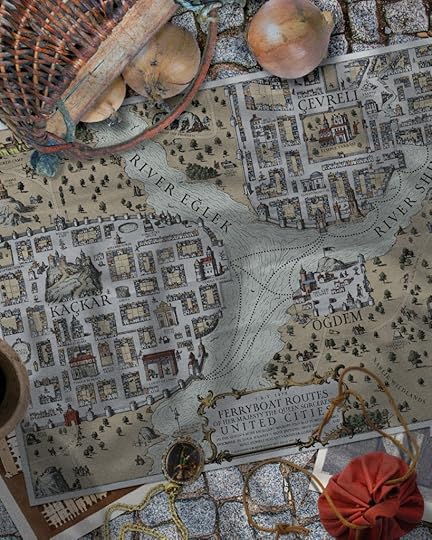 1080×1350 (893 KB)
1080×1350 (893 KB)Sample Details: I hand-drew both the landmasses and water texture in Photoshop. The font is Map Roman Variable, which I licensed through Adobe Fonts. All the names come from either locals in Turkey or are taken from Turkish surnames. The paper texture is from True Grit Texture Supply’s Infinite Pulp, and they’re also where I got Atomica, which gives me ink-like effects for the text, the roads, the ferry routes, basically everything—big fan of their tools.
Like that water texture? If you want to achieve similar results with the water texture on your map, I’ve put together a click-to-place set of free brushes. Since they’re not part of the original source material, I’m offering them as a separate download.
Download the Hogenburg Sample Map Water Texture Set
(186 KB)
Download the Hogenburg Sample Map Water Texture PNG Pack
(321 KB)
Brushes and tools released through the #NoBadMaps project will always be free and released under a public domain CC0 license. If you’d like to support the project and help me cover the cost of hosting, research, and tool-set development, I’ve put together three ways you can help, and all are detailed below.
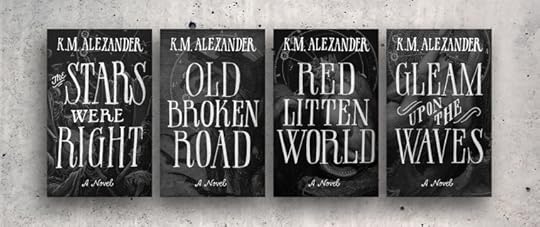 Buy My Books→
Buy My Books→
I’m not just a map enthusiast. I’m also a novelist! The easiest way to support me (and get something in return) is by purchasing one of my cosmic horror urban fantasy novels.
❦
 Buy Me a Coffee→
Buy Me a Coffee→
A simple and quick way to support the #NoBadMaps project is through a one-time donation of any amount via ko-fi. Your support helps keep this project going and is appreciated.
❦
 Join my Patreon→
Join my Patreon→
If you want to continually support the #NoBadMaps project through a reoccurring monthly contribution, consider joining my Patreon and get sneak peeks into what’s coming.
❦
More Map BrushesThis is just one of many brush sets and map tools I’ve released. You can find it and other free brushes covering a wide variety of historical styles on my Fantasy Map Brushes page. Every set is free, distributed under a CC0 license, and open for personal or commercial use. I’m sure you’ll be able to find something that works for your project. Click the button below to check them out!
view more Fantasy Map Brushes
Want to stay in touch with me? Sign up for Dead Drop, my rare and elusive newsletter. Subscribers get news, previews, and notices on my books before anyone else delivered directly to their inbox. I work hard to ensure it’s not spammy and contains interesting and relevant information. Sign Up Today →
August 12, 2024
Meet the Flock
When we purchased our new house, we inherited a flock of chickens: eleven hens and one surly rooster. We didn’t necessarily want chickens. We could have turned them down, but it felt mean to remove them from their home. So, we brought the flock along for this ride. And honestly, it’s been great. They’re an absolute delight, and now we have a dozen new pets. On top of all of this, the bonus of never buying eggs has been nice.
The previous owner had a pretty slick setup, so the daily chicken chores are menial. The labor is quite painless, and the coop requires minimal cleaning as long as we check in once a day or so. We mostly check food and water, give them treats, and collect their eggs. Sometimes, we’ll get to hold one or two. Some of them seem okay with it? Others don’t and make that very clear.
We’re still discovering the nuances of each chicken’s personality and trying to determine which breed each one is. Below is a little introduction to the flock. I’ve included our best guesses at their breeds below their names. It’s all speculation on my part based on comparing photos and details from random breeding info sites. I could be wrong—I probably am! If you are an expert chicken knower, please correct me in the comments! Let’s learn together, or just school me.
Okay, enough talk; let’s meet our flock!
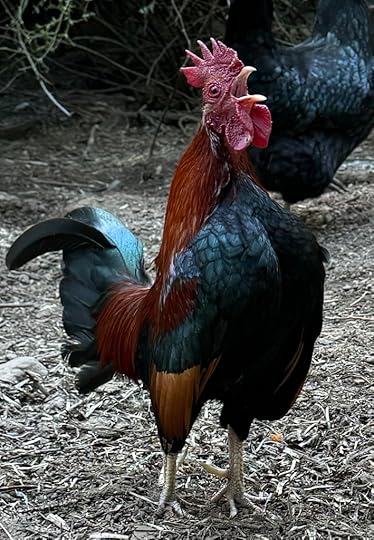 RossB.B. Red Old English Game Bantam
RossB.B. Red Old English Game BantamThe smallest chicken of the flock, but arguably the biggest personality, is the short king himself, our bantam rooster. Ross believes himself to be the leader and protector of the flock, but I am pretty sure no one takes him seriously. He’s loud and crows often, especially during treat time. The coop and run are far enough from the house that we don’t hear him in the morning. He’s a lot of fun and adds a certain panache to the coop. He came with the name, and honestly, he’s a Ross—any other name just wouldn’t work.
HelenBlack Australorp mix?This ashy gray hen with dusty undertones is named after Washington’s own Mt. Saint Helens. She’s got a similar vibe. While she’s not the boldest of the bunch, she is friendly and somewhat active, occassionally she’ll be at the front of the flock, especially during treat time.
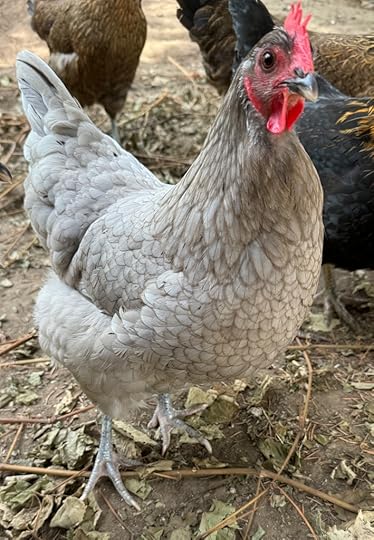
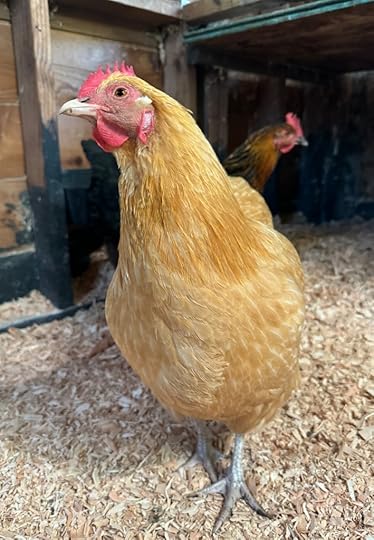 HenriettaBuff Orpington
HenriettaBuff OrpingtonThis ginger beauty is the biggest of the birds. But she tends to be gentle, kind, and friendly with visitors and the rest of the crew. Ross might think he’s in charge, but it’s pretty clear that Henrietta is queen of the coop. She’s never mean but often eats first, and takes charge. The others follow her lead. Even Ross, though he would never admit it.
ClassicBlack AustralorpThis hen has beautiful dark feathers that look black in the shade but glow green in the light. She is friendly but sticks to the back of the flock for the most part. Our run and coop are nice and shaded, which I am sure she appreciates during the hot summer. I like her. I think she’s slowly growing more accustomed to our visits.
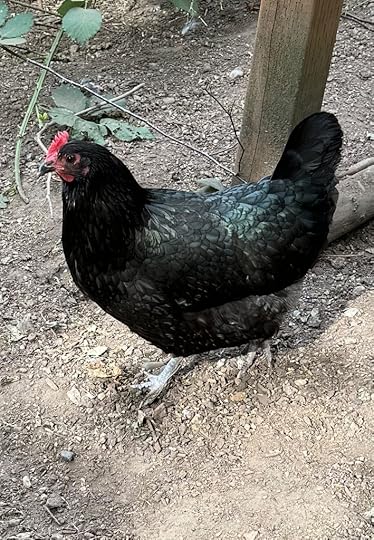
 Winnieblack Silkie bantam
Winnieblack Silkie bantamThe first of our pair of Silkies, Winnie—named by our friend Steve—has been very broody[1] since we moved in. To make it more complicated, she likes to nest outside of the nesting boxes, usually in the back corner of the coop, where she’s hard to reach, and she is quick to peck at me whenever I attempt to move her. That said, she’s gotten better in the last few weeks. She’s best friends with our next chicken, and the two are often found together.
Comfy Cozywhite Silkie bantamNamed by our three-year-old niece, this hen is the opposite of her shadowy doppelganger. She’s sweet, curious, and has a funny run. (Okay, they both have a funny run.) She might look bright white, but she is the dirtiest of the birds and is often found covered in filth from her most recent dirt baths. She also will get up in the business of the other hens if she’s upset, and considering she’s one of the smallest birds, it’s a bit surprising. (And also kinda cute.)

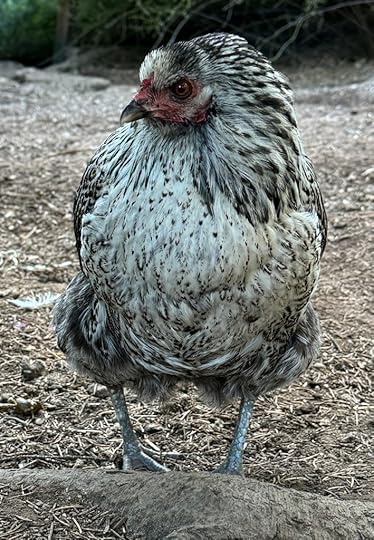 HawkeAmeraucana Mix? Cuckoo Maran?
HawkeAmeraucana Mix? Cuckoo Maran?With no comb or wattle and a distinctive coloration, this hen looks more like a bird of prey than a chicken. Despite her appearance, she’s friendly and very curious and often follows me around while I do the daily chores. She was the first bird we picked up, and she’ll let us pet her during snack time. Much sweeter than that furious visage suggests. She’s gruff but kind. I love her.
SweetnessBlack Australorp? Blue Andalusian?This hen is an absolute sweetheart and keeps wooing herself closer to my heart. She coos and clucks and is gentle when picked up. She’s one of the bigger in the flock, and has been broody in the last few weeks. She always complains in the softest way possible when moved.

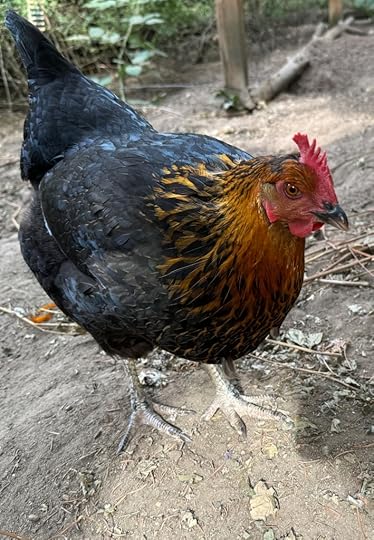 BokgoniaBlack Star
BokgoniaBlack StarNamed by our traveling pals, Kelcey and Jim, this hen is curious by nature but skittish by design. Often brave enough to hang out at roost level to watch what I am doing, she won’t let me get too close. That said, in the last few days, we may have had a breakthrough. That or I was just lucky enough to surprise her and hold her for a bit.
The TwinsBrown LeghornThey aren’t actually twins, but their coloration and behavior are such that unless they’re standing next to one another, it’s hard to remember which is which. Luckily, these two are best friends and are rarely more than a few feet apart, so they are collectively “The Twins.” Big Twin is a little bigger than Little Twin, and both are hungry little goblins.
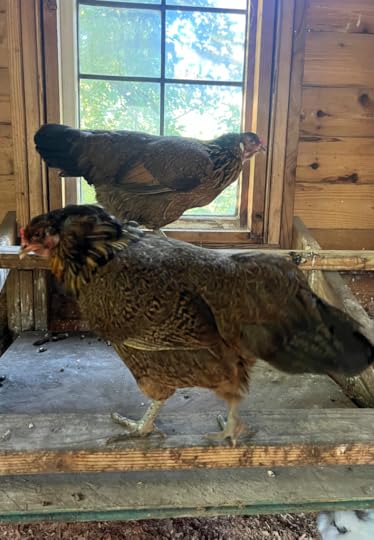
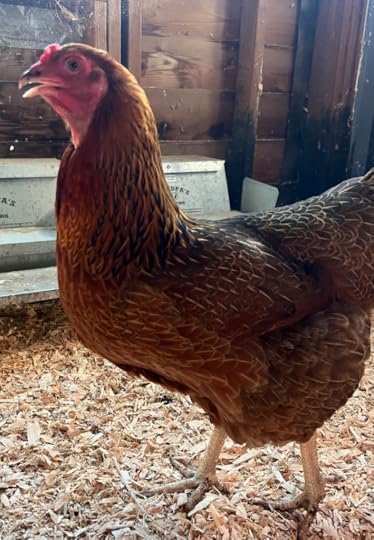 Ol’ Redred Leghorn… Maybe?
Ol’ Redred Leghorn… Maybe?This is our true ginger. The ruddiest of the bunch. Almost copper in the sunlight. This quiet and shy hen rarely stands out from the crowd and tends to hang back like a wallflower. Unless, of course, mealworms are involved, then like every other hen, it’s a frenzy.
So, that’s the flock. With Uly, we now have thirteen pets. (Yes, the chickens are our pets, sorry, Papa [2].) We’ve really taken to all of them, and it has been fun settling into our new roles as egg moguls. Uly likes them, too, though he’s not allowed to interact with them directly. For their part, the chickens keep well away from him—which triggers his herding instinct. (We’re working on it.)
In the last month or so, we’ve been overwhelmed with eggs—some of these breeds will lay up to three hundred eggs a year, and we have eleven laying hens. That’s… uh, quite a lot of eggs for two people. Even for two people who eat a lot of eggs. Supposedly, there are quite a few island farms that would be interested in buying. Until then, we’ve been giving them away to neighbors, friends, and family. They are great eggs.
I am sure there will be more chicken stories to come. This isn’t technically a farming blog, but only the boring subscribe to rigid classifications. This is the internet! Explore cool stuff. Get dirty. Be weird. Chicken content can live right alongside cosmic horror, fantasy maps, and riverboat facts. There’s going to be plenty more to come, hell… I’ll have lumberjack stories before the year is out, I am sure.
Stick around.
[1] Broody hens are chickens who VERY MUCH want to raise chicks. The maternal instinct is strong even if no rooster is around. They’ll only leave their nest two or three times a day to eat, drink, and poop. They’ll lose weight. Pluck their feathers for a nest. Even steal other hens’ eggs! During the hot summer months, it can be dangerous and even deadly. So “breaking” their broodiness is important. (I just learned about this! Who knew? Chicken people, apparently.)
[2] Papa—or William “Bill” Gornick (1917–2002)—was my quiet, kind, and stalwart cattle-rancher grandfather. A man I adored, and one who had a much more pragmatic approach to animal husbandry than I will ever have. I can picture him smiling, shaking his head, and quietly laughing to himself at the thought of me naming all my chickens and thinking of them as pets. He’d think it was silly, he tolerate it, and he still love me for it.

Want to stay in touch with me? Sign up for Dead Drop, my rare and elusive newsletter. Subscribers get news, previews, and notices on my books before anyone else delivered directly to their inbox. I work hard to ensure it’s not spammy and contains interesting and relevant information. Sign Up Today →
July 12, 2024
Becoming Islanders
I live on Vashon now—well, technically, Maury Island, but ever since they built the isthmus in 1913, it’s all kinda one island.
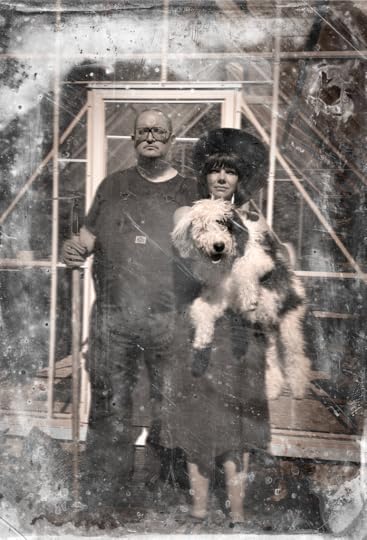 K. M. Alexander, Kari-Lise Alexander, and Ulysses
K. M. Alexander, Kari-Lise Alexander, and UlyssesAfter a fraught spring, the event we had been building towards finally happened. Kari-Lise and I have a new home—hopefully, our forever home—on the largest island in Puget Sound. (It’s not quite thirty-seven square miles, a little larger than Manhattan.) It feels really good to be here.
When we first moved to the Seattle area in the spring of 2008, we knew nothing about Vashon, but we were eager to explore the surrounding area, including the numerous islands that dotted the waters. That autumn, Kari-Lise read about Vashon in a magazine. That magazine laid out a day trip to the island, which suggested parking near the Faunterlory Ferry in West Seattle, walking onto the ferry, renting bikes at a bike rental on the Vashon side, and biking to all sites around the island. Seemed like a lovely way to spend a Sunday. Before this, we had explored other islands in the Sound: Bainbridge, Whidbey, and a few of the San Juans. All had similar options, so this seemed like a no-brainer. We followed the instructions: Walked onto the ferry. Walked off. Looked for bike rentals. And… there was nothing.
An old restaurant—the only commercial space near the ferry terminal—was boarded up. (Sixteen years later, it’s now a lovely market.) Any bike rental option that might have been near the ferry was long gone. We had walked past a bus. But by the time we realized there were no bike rental options, the bus was long gone, up a hill and around a bend.
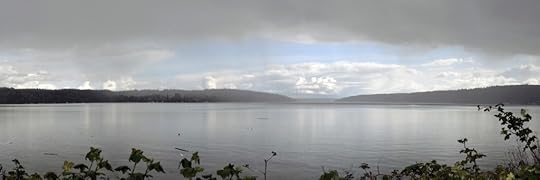 Panorama of the less-protected southern portion of Quartermaster Harbor, Puget Sound, looking south from Burton, Vashon Island, Washington (2010, April 28)
John Mabel
CC-BY-SA-3.0
Panorama of the less-protected southern portion of Quartermaster Harbor, Puget Sound, looking south from Burton, Vashon Island, Washington (2010, April 28)
John Mabel
CC-BY-SA-3.0So, we decided to hoof it; all other islands we visited in the Sound had sizeable towns right by the ferry terminal, so we figured the town of Vashon couldn’t be too far. Just around the bend, right? So we stuck to the shoulder and began to climb up the hill. The town wasn’t around the first bend. Nor the second. Nor the third. After a mile of climbing, we reached the crest of a wooded hill with a few scattered homes and a fire danger sign but no town. Sensible people would have turned around, but we did not. We kept walking.
After another mile or so, we eventually came to a real estate agency tucked into a grove of trees. The person working inside informed us that the town of Vashon was another three miles up the road. Already two miles in and growing hungry, we decided to continue our trip. We passed a sign for a taxi service, thinking it’d be our solution. When we called, we were informed that it wasn’t running that day. Around then, it started to rain.
After a very wet hour’s walk, we finally entered the small town of Vashon, five miles from the ferry landing. Famished from our unexpected journey, we entered the first diner we saw and sat drip-drying and warming ourselves as we ate a (now very) late lunch. We didn’t spend much more time in town. Tired from an unexpected walk and soaked from the rain, we caught the bus as it was heading back to the ferry terminal. It wasn’t an auspicious first visit to the island that would become my future home.
A few weeks ago, as I drove a Uhaul loaded with boxes across the West Seattle Bridge toward the Faunterlory ferry, I reflected on that first visit to Vashon. Even during an unexpected long walk in the rain, something about Vashon had hooked us. Every time we made subsequent crossings and drove off the ferry, something within us eased. Going to Vashon felt a lot like going home.
 Fauntleroy Ferry Terminal as seen from Fauntleroy Way SW, Fauntleroy, Seattle. (2023, September 17). In
Wikipedia
.
Fauntleroy Ferry Terminal as seen from Fauntleroy Way SW, Fauntleroy, Seattle. (2023, September 17). In
Wikipedia
.We returned, and we did it right. Many subsequent visits followed. Over the years, we found ourselves falling more and more in love with the island and its community. Going to Vashon became a fairly regular weekend activity for us. We made friends on the island. We got to know its backroads. We took visiting guests on day trips. We frequented its stores and restaurants; we attended festivals and events; we shopped at its farm stands and nurseries. Sometime along the way, we began to talk about eventually moving. In 2013, we explored the idea of buying property and building a home. Life intervened, and the idea collapsed, but that didn’t stop our love affair. During the pandemic, we spent a lot of time on the island, working from rented cabins and exploring on our own.
This brings us to 2024, sixteen years after moving to Seattle and almost sixteen years since that first long walk in the rain. Our garden in the Mt. Baker Neighborhood had grown too small, and while we adore Seattle and still do, something in us craved change. So, we decided to take the plunge. We sold our house and began looking for new property on Vashon. As I detailed in my previous post, it’s been an arduous journey. The last few months have felt like years. But the end result has been worth it. As of July 27th, we’ve become islanders.
We wanted a house smaller than our last with a big garden, but we fell in love with a bigger house with an enormous garden filled with berries and fruit trees—well over an acre. We now own a flock of chickens overwhelming us with eggs and a rooster named Ross overwhelming us with crowing. These last few weeks have been fun, and it’s often surreal. We’re all—Uly included—slowly figuring out this new pace of life we’ve chosen. We keep reminding ourselves we’re no longer visitors but residents. We live here now. This is our home.
What will the next adventure in our life bring? Time will tell. We’re just starting down this new trail, and we couldn’t be more excited.
(You still can’t rent bikes at the ferry terminal.)
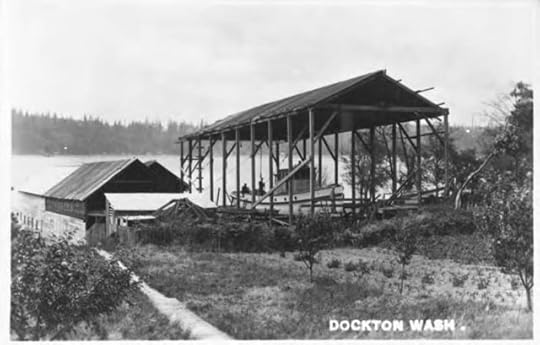 Boatyard at Dockton, Washington, ca 1918
Boatyard at Dockton, Washington, ca 1918
June 17, 2024
April is the Cruelest Month
This has been a difficult post to write. I’ve written and rewritten it over the last few weeks, but I never liked how it came out. This is an attempt to correct that. It is always challenging to write about an experience in the middle of the experience. These last few months for us have been surreal—full of exhausting emotional swings in directions I never expected.
As readers of this blog know, we embarked on an adventure to sell our house in the Mt. Baker neighborhood of Seattle and relocate to a new place. What new place? We had no idea. The sale of our house would help determine that. The Seattle housing market is still chaotic, and for most of February and March, we toiled on our home with the goal of moving out by March 28th and list it by April 4th.
That didn’t happen.
What transpired has been one of the most stressful moments of my life. Even taking the time to write a blog post seemed daunting. But for a while, I’ve felt like I needed to share our last few months. Getting this story out has been something of something of a block for me. Nothing has worked. I tried many angles before landing on this. Turns out the best way to share this story is in diary format. Even now, looking back at our time, the sheer number of bizarre occurrences appears manufactured. If someone wrote this as a plot, I wouldn’t believe it. But all this happened, and they all occurred as follows.
March 24thWe’re nearing the end of all our house prep—one more week, and we’re nomads. I make a meal to celebrate. At the end of dinner, Kari-Lise feels like a piece of food is stuck in her throat. It’s like a pressure. It’s painful, but she can eat, breathe, and drink water just fine. She goes to bed. I worry about her.
March 25thPain remained the following day. She can still breathe, eat, and drink just fine. Kari-Lise goes to a doctor who thinks something might be lodged in her lower esophagus. They suggest going to the Emergency Room, which we did. Emergency ordered a CT scan and detects a cyst on her thyroid. They recommend going to an Ear, Nose, and Throat specialist for an ultrasound, which is scheduled for the first week in April.
March 28thAfter months of home improvement projects, we are finally done and ready to move out of our Mt. Baker house in Seattle. Most of our stuff is packed and stored in various storage locations. A few pieces of furniture and some art are left behind for staging. We head to Vashon Island for what we hope will be a relaxing Easter Weekend. We even have plans to cook dinner for friends on the island on Sunday. We hire cleaners to come out and deep clean the house.
March 29thOur agent calls. The sewer scope and pre-home inspection happened this morning. Both had terrible news. The sewer scope hit what looks to be a blockage; home inspection detected moisture on the inside, which could be significant. We’re stunned. None of this was suspected. We had no evidence of either being an issue and saw no damage to our stuff. We decided to cancel our weekend and return home to organize repairs—no way we’re listing by the 4th. The disappointment weighs on us, and we face what we think at the time is heartache.
March 30thWe get a new nephew! His name is Moses. Moses Alexander sounds like a good NFL running back’s name. Some friends come and visit us on the island, and we go to dinner. It’s lovely, and we have a nice time despite the blues from the news the day before.
March 31stWe return home to a very clean and very empty house. We now live here out of suitcases. We still make Easter dinner for friends. It turns out okay despite everything we have packed away in boxes.
April 2ndA sewer company comes out to inspect the blockage. They have to jet it away. Once removed, they further scoped the line, detecting at least two breaks. The sewer line is shared between our house and our neighbor’s to the North. We reach out to them to see if they’ll help. The neighbor refuses to share the repair cost. The only solution would be to take them to small claims court. That’s not worth the time or money. We’ll let karma run its course. The repairs have to be done if we’re going to sell, so I authorize the sewer company to start.
April 3rdA water mitigation contractor comes out. Two of the three problem areas are not of any concern—a small break in our favor—but one, however, is significant. It will require installing a French drain with a sump pump below the foundation inside the house in the fully finished basement. Sewer repair begins.
April 4thKari-Lise goes to ENT for an ultrasound. The cyst is concerning enough that the doctor decides to do a biopsy the following week. Sewer repairs continue.
April 5thSewer repairs are nearly finished, but a third break is discovered. Another (and final) repair is authorized. Weeee…
April 8thThe water mitigation contractor installs the French drain. They complete their work in a day. It goes smoothly, but refinishing the basement needs to be handled by a different contractor.
 Basement floor pre-repair
Basement floor pre-repair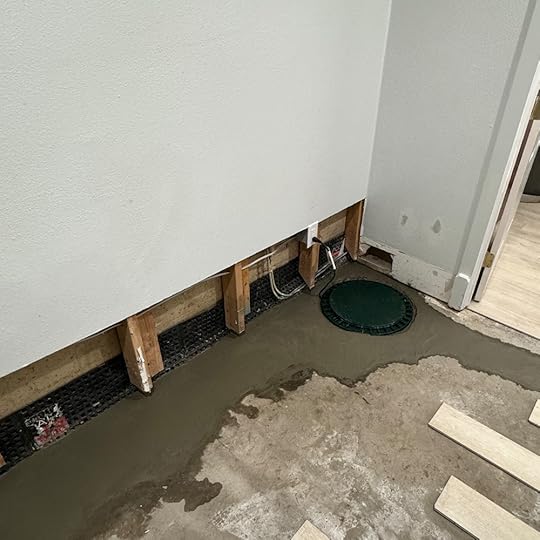 Basement floor in the middle of repair
Basement floor in the middle of repair Basement floor toward the end of repairApril 10th
Basement floor toward the end of repairApril 10thKari-Lise has a biopsy on the cyst. Results should come back in seven to ten days. My friend Steve volunteers to help with the finishing work in the basement. Somehow, he’s able to get it looking new by the 11th. We are so grateful.
April 12thKari-Lise has a diagnostic mammogram to look into some pain. This has been a source of stress for many months, and it took a lot of time to get scheduled. It’s not cancer. The emotional release is palpable. We spend the rest of the day finishing the house projects. Getting sick of it.
April 13thRepairs complete. House in order. We move out again. I’ll never understand how all this was completed in two weeks. The new goal is to list April 18th. We move into an apartment in Pioneer Square, one of the older neighborhoods in the city. Cleaners come back out to clean up the mess two adults living out of suitcases leave behind.
April 15thSewer work is complete.
April 14thI go to a Mariners game alone because the stadium is a block from my temporary apartment; it’s an easy walk, so why not? It’s hard not to worry about the biopsy throughout. Mariners lose.
April 18thHouse gets listed. Three open houses that weekend. All well attended.
 Front Entrance of our Mt. Baker house.
Front Entrance of our Mt. Baker house. Dining room with a view of Lake Washington
Dining room with a view of Lake Washington Mt. Baker house from aboveApril 20th
Mt. Baker house from aboveApril 20thWe move to a temporary apartment in Uptown, just a few blocks from Moth & Myth’s studio and the Space Needle. I get coffee at the KEXP studio in Seattle Center. It all feels very Seattley.
April 23rd (Morning)Kari-Lise has an art installation in New York City with Moth & Myth that has been delayed since November. Somehow, it fell on this week. Rather than finding two places to stay, I decided to join her, fly out, and work from the hotel room. It’ll save us money, and I can hang out in New York. It seems like a win-win. We fly out early.
April 23rd (Evening)OUR HOUSE SELLS. We’re ecstatic. We accept a solid offer from a lovely couple. I panic a bit about the uncertainty of our future. We don’t have a new home and will be continuing to nomad. The closing date is set for May 14th. We go to dinner that night in Chinatown to celebrate. I feel better after some food; in fact, I start to feel excited.
April 24thTwelve hours later, the ENT calls while Kari-Lise is on a ladder in the middle of the installation. She has thyroid cancer. The wind is sucked from our sails. Our world narrows significantly. Everything outside of us immediately feels unimportant. We cry together in a park in Tribeca. We wander SOHO in what now feels like a daze. We somehow went to a Broadway show, and I think it was enjoyable? We both cried at all the slow songs and occasionally some upbeat ones. We fall asleep crying.
April 25thThe show Moth & Myth participated in has its soft opening. We visit and check it out and spend time with some lovely friends. We try to forget the cancer diagnosis. (We fail, but it’s nice to pretend.)
April 26thWe leave New York. The whole trip feels stained; any fun was muffled by the cloud that now hangs over us. We arrive home emotionally exhausted. Kari-Lise’s first doctor appointment is scheduled for Monday, the 29th. We make the hard phone calls we didn’t want to make and tell our families about the diagnosis. We cry in the car. I cry in a park. We take a ferry to look at a house on Vashon Island and consider making an offer—it’s a weird day. We move back into our now sold and still staged house to prep our final move. It’s like living in a movie set.
April 27thWe go to the zoo for our niece’s birthday.
April 28thSince Sugar passed away, we had always planned to buy a dog when we arrived at our next house. That plan changed when cancer entered our lives. So we buy a dog. He’s a puppy. He’ll be ready to come to us in a few weeks. It’s precisely the distraction we needed. We assemble many lists: toys, gear, and, of course, names.
April 29thKari-Lise has her first post-diagnosis visit with her ENT. Her doctor is encouraging. “If I could pick any kind of cancer besides a little skin cancer, it’d be thyroid cancer.” It’s a nice thing to say, but it’s still cancer, you know? Her prognosis is excellent. They caught it early. She’s young. Her thyroid is going to be removed, and she’ll be on medication for the rest of her life. Neither of us has ever been on any long-term meds. It’s a strange thing to face suddenly. They’ll call in the week to schedule her surgery. That night, we take Cosmo, a fiend’s dog, to a Mariner’s game. The Mariners win.
April 30thThe furnace goes out.
“April is the cruelest month.”
Good riddance.
My division of my former company is sold to another company. I knew this was coming for a while. But the exact date was fluid. Of course, it all happens now. Not much has changed, yet everything has changed. I work for the same boss, with the same coworkers, and on the same products, but I’m essentially starting a whole new job. This means I get to complete all that new employee paperwork, read new employee handbooks, watch new employee welcome videos, set up a new employee laptop, oh… and my insurance is switching, right as we’re trying to schedule a pretty critical surgery.
May 2ndThe furnace is tuned up. It turns out the oil company forgot to fill up the tank; no oil = no heat. Oh, we also got a quote from movers for the last of our stuff. Final move is scheduled for the 13th. The doctor’s office calls to schedule Kari-Lise’s surgery, and we let them know the insurance switchover is happening. Of course, this throws a wrench into that plan. I request new insurance information ASAP.
May 3rdI get a member ID number and a letter of coverage from the insurance folks. This doesn’t help the insurance company find us. The hospital is holding a date for surgery if we can prove coverage. This is a whole added stress I never anticipated.
May 6th—9thAfter hours on the phone over several days, we’re finally located in the system, and Kari-Lise’s surgery is scheduled for the 16th. Meanwhile, we’re gathering the last of our things for the final move-out.
May 10thFinal paperwork signed. The house is sold!
May 11thMy sister graduates from the University of Montana! We were supposed to be there, but cancer interrupted everything.
May 13thFinal move-out day. Movers arrive in the morning. We leave them to their work and rush off to look at a fixer-upper on Vashon Island. It turns out to be much more than we want to handle or could probably afford. We move into an AirBnB in the Maple Leaf neighborhood. The whole day feels weird and strangely melancholic.
May 14thHouse closes! We’re done!
May 15thUlysses arrives! He’s a much-needed balm on the chaos of our lives. We fall in love immediately. Kari-Lise has surgery tomorrow, so I take puppy duty that night. I do not sleep well. I don’t care.
May 16thKari-Lise undergoes a total thyroidectomy. It was scheduled for 11 AM, but the hospital decided to move her up and not tell us or her ENT. After some phone calls, this means we rush through the morning vs. calmly easing into a scary procedure. She gets checked in by 10:30 AM. The rest of the day is an emotional blur. The surgery is very successful and the doctor is pleased. I cry in the waiting room a lot while she recovers. I’m crying in public a lot these days. Kari-Lise recovers well and gets sent home that afternoon. Friends visit, and we all have dinner before we crash out. I sleep with the puppy on the couch. “Sleep.”
May 17thRecovery day one. Visits from family. Kari-Lise is exhausted.
May 18thRecovery day two. After a quiet few weeks, a new house arrives on the market on Vashon Island. Why now, of all times? Kari-Lise is still pretty tired. Ulysses is a gem.
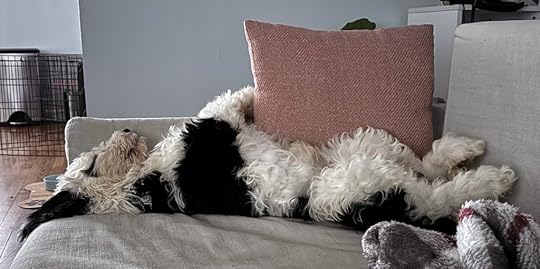 Ulysses often sleeps on his back. It’s adorable and hilarious.May 19th
Ulysses often sleeps on his back. It’s adorable and hilarious.May 19thRecovery day three. Redd comes to spend the morning with Kari-Lise, and Steve and I go check out that new house. It’s very intriguing—maybe perfect? I give Kari-Lise a Facetime tour before returning home. We decide to return to the house in a few days if it’s still available and Kari-Lise is feeling up to it.
May 20thRecovery day four. Kari-Lise wakes up and feels really good for the first time post-surgery. We have a quick family visit from my folks. She’s feeling good enough that we bump up that viewing by a day and check out the house later that afternoon. It looks perfect.
May 21stRecovery day five. We make the jump and put in an offer on the house in the morning. It’s accepted by 2 PM that afternoon. It’s only been one week to the day since our last house closed. Folks, we are moving to Vashon Island.
There are so many more details, both good and bad, that I skipped out on when composing this timeline. Both of us continued to work during these events, somehow. It often feels like we’ve lived three lifetimes over the course of the last four months. Looking back, the physical exhaustion of weeknights and weekends filled with house projects in February and March seems quaint compared to the emotional drain of cancer sitting on top of the stress of major house repairs, house sale, and the coordination of a move. (Not to mention moving every few weeks with a puppy in tow.)
Kari-Lise remains in recovery but continues to improve every day. She’s eased back into work and feels good; her energy level has been solid. There’s more to come, of course: meetings with endocrinologists, meetings with oncologists, and radioisotope therapy. She’ll have frequent visits with her ENT for the next five years. Cancer is always scary, and it’s run us ragged over the last month and a half. Despite the victories in recent weeks, it’s impossible not to experience a twinge of anxiety and swells of despair, all dripping from that black cloud that continues to loom over our shoulders. We’re managing. There are good days and bad. The nomadic life we’ve been living since the sale has left us with a feeling of being unmoored. On its own, I think it’d be manageable. But coupled with a health crisis it has left us feeling more adrift than we expected. We’re excited to get into the new place, and we’re excited to finally have a place to settle.
We continue to be in the throes of house buying, only this time, we’re on the opposite side of our experience in April. Hurry up and wait is the name of the game. Things are looking good, and everything is progressing nicely. In many ways, we’re ahead of schedule. Fingers crossed, we’ll be in our next place by the end of June. I’m holding off saying more until we’re there. But expect plenty of updates once it all happens.
Until then, we’re digital nomads as we planned way back in February… well, kinda. Now, we’re digital nomads with a puppy. Ulysses is now fourteen weeks old, and he’s a ball of endless energy. While he remains a sweetheart, he’s currently teething, which is an added challenge when your “little” pup is over twenty-five pounds. We’re figuring it out, and it’s been fun overall. All the while, he has brought us immense joy and plenty of distractions. It seems like a wildly stupid idea to buy a puppy in the middle of a maelstrom like we’ve been experiencing, but honestly, he was the best decision we could have made.
I cannot thank our friends and family enough for their love and support—from the meal train, the visits, puppy sitting, flower, snack deliveries, and general comfort and understanding. We felt loved throughout this experience and couldn’t have done this without the help of our family and our community of friends. It meant so much, even to my desiccated heart, and it’s not something we’ll ever forget.
It’s funny Eliot begins “The Waste Land” lamenting the cruelty of April. But only eight lines later, he writes:
“Summer surprised us.”
I suppose we’ll find out.
May 26, 2024
Meet Ulysses
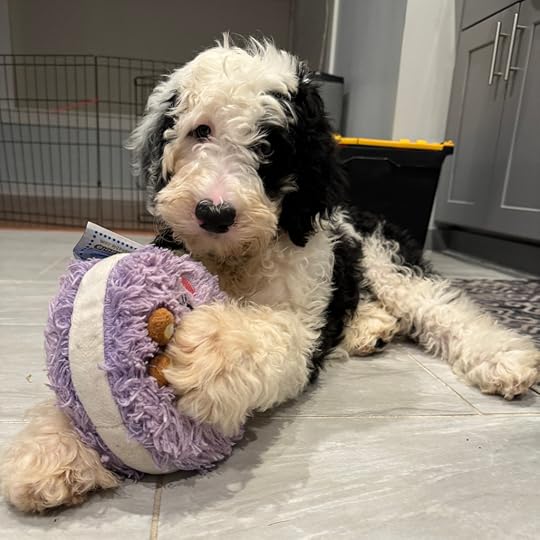
T. S. Eliot was right; April really is the cruelest month. Thankfully, May is already a significant improvement. Meet the newest Alexander, Ulysses, our twelve-month-old sheepadoodle. (We call him Uly.) He’s super sweet and very silly. Already clocking in at over thirty pounds, we figure he’s going to be a big boy.
I’ll write more about the chaos of the last few weeks when I can wrap my mind around it. Until then, please enjoy this photo of an adorable pupper.
March 19, 2024
My Times Are A-Changin’
It’s been quiet around here, and for that, I apologize. Kari-Lise and I have been prepping to list the house we’ve lived in for the last fourteen years for sale. Turns out that’s a lot of work! Over the last three days, we’ve painted our picket fence, touched up our house’s exterior paint, painted my office, power-washed the world, stained our enormous deck, cleaned up our yards, and taken many trips to storage. A lot of it is standard spring chores, but in the past, we’ve been able to spread them out over the weeks and months and not complete them all over a handful of days. As you can imagine, with all that work I have only found a little downtime for my personal projects. But there is an end date in mind. Only about a week and some days left, and I expect my time to open up after that, and I can get back to making cool things. (And frankly, I look forward to it.)
For my readers: I’m still writing, albeit less than I would like. I’m up to seventeen chapters in book five, and I’m making headway on the eighteenth. For my map fans: I have a new urban map asset pack that is nearly ready, though I still need to make a sample map and organize the assets. It’s about a day or so of work, and I expect it’ll launch sometime in April. I also have a few new Raunch Reviews in the works—a series that has been woefully neglected.
As for where we’re going to end up, we’ll see! We have some machinations about where we want to land—an island, most likely—but once our house sells, I expect us to drift a bit. We have an ideal property in mind and are patient, which puts us in a good position. The whole experience is equal parts terrifying and exciting, but then again, what adventure isn’t?
February 28, 2024
We Need to Talk About Your Rivers
The “rule of cool” is a common piece of advice for artists. Let your imagination run wild. And that applies to fantasy as well. By its very nature, rules are meant to be broken. It’s part of the mystique. It’s why the genre can be so compelling. But to really break the rules effectively, it helps to have a solid comprehension of the underlying contexts. The rule of cool can backfire when we push boundaries without some rudimentary knowledge of the foundations on which boundaries are based. Instead of feeling vibrant and innovative, the work can come across as lacking depth and intention, losing its logical consistency, and coming across as hackneyed, as if we’re not putting in the effort required to create something meaningful.
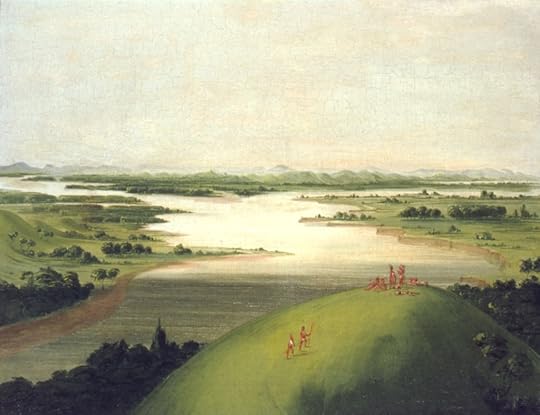 Mouth of the Platte River, 900 Miles above St. Louis, by George Catlin, 1832
Mouth of the Platte River, 900 Miles above St. Louis, by George Catlin, 1832That brings me to today’s topic: rivers.
When it comes to rivers, I’ve noticed that quite a few fantasy writers don’t understand the basics. While their intent is noble, I’ve seen plenty of examples of authors struggling with the underlying science of rivers and river systems. I sympathize. These are mistakes I have made myself. Early on, in one of my first projects, I made a mess with the waterways in my fantasy world. Mistakes like these—I like to jokingly call them “river sins”—might go unnoticed at first, but when they are noticed, they can draw a reader out of the story or setting. It wasn’t until I later learned more about the behavior of these ecosystems that I was able to hone in on my worldbuilding, and the end result was something much more interesting and complex. The cool got cooler.
Rivers and waterways have played an influential part in humanity’s history, so it makes sense they also have a meaningful place within our fantasy work. Civilizations have been built around their tendrils of life. Battles have been fought over their control. They have served as highways, borders, walls, temples, power plants, and the source of fresh water and food. It’s no wonder they play a part in our stories. I’ve worked with fantasy maps for a while now, and my experience has given me a unique insight. Information I wish I had early on when I started my first forays into worldbuilding. I’ve found by following a few simple tips, you can use river systems more effectively within your fantasy stories and use them to enhance your work and further draw a reader into your creation.
What are those tips? Let’s talk about them.
Rivers are FractalOne of the biggest mistakes I see comes from a misunderstanding of how rivers behave. Water seeks a path of least resistance; they are fractal for all intents and purposes. Smaller streams feed into more significant streams. They flow from a higher elevation toward a lower one. These are called Stream Orders, with the smallest being tiny 1st-Order headwater streams and the largest being enormous 12th-Order rivers. Depending on the geology, watersheds can flow in various patterns—the tree-like dendritic systems, the angular rectangular systems, the narrow parallel systems, the unpredictable contorted/deranged systems, and more. Still, the end result is the same, smaller waterways flowing into more prominent channels and then into even bigger ones before they empty into a basin of some sort. (We’ll get to those later.)

Dendritic

Parallel
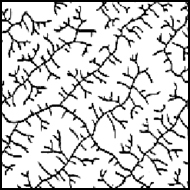
Trellis
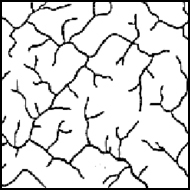
Rectangular

Radial
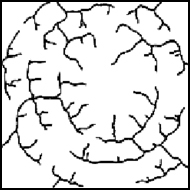
Annular
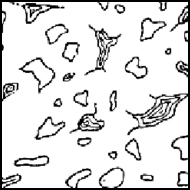
Multi-Basinal
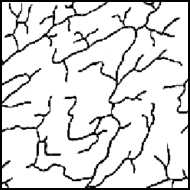
Contorted
Examples of drainage basins by A. P. Howard, AAPG, 1967
Rivers are AliveUnless your fantasy world has a corp of engineers, odds are your river will be alive and unpredictable. It’ll move and change channels; sediment will build up, causing a shift down a different path. An earthquake will happen, causing a landslide, and suddenly, a new lake is formed, and the water will find a new exit. A log jam upstream might send a river in a completely different direction, leaving a former river town high and dry. Depending on a river’s stage, these can happen quickly, or these shifts can take years. But unless it’s forced by humans (or beavers), your rivers will move. This movement is called a meander, and it can create some fascinating landscapes. Dry rincons, cutoff oxbow lakes, and point and scroll bars are all formations built by a river’s meander. While these meanders don’t necessarily have to play a part in your plot, knowing that rivers move is essential when laying them down in your fantasy world.
Rivers Have Three StagesThese are classified as youthful, mature, and old. This isn’t a reflection of a river’s actual age, but its behavior, and a single river might have multiple stages along its course.
YouthfulThese waterways have a steep gradient, few tributaries, and a fast flow. Its channels erode deeper rather than wider. (Zone 1 in the illustration below.) The Skoga River in Iceland is a youthful river.Mature
These rivers have a gradient that is less steep than those of youthful rivers and, as a result, flow more slowly. Many tributaries feed a mature river, and they have more discharge than a youthful river. Its channels erode wider rather than deeper. (Zone 2.) The Ohio River in the US is a mature river.Old
Like a curvy river? Then you’ll appreciate the old rivers. A river with a low gradient and low erosive energy. Meanders, oxbow lakes, and broad floodplains characterize old rivers. (Zone 3.) The Indus River flowing from the Himalayas would be considered an old river.
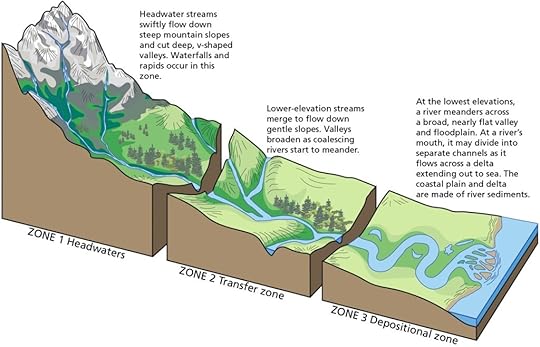 Source: Trista L. Thornberry-Ehrlich, Colorado State University.If Your River Crosses a Continent, It’s Not a River
Source: Trista L. Thornberry-Ehrlich, Colorado State University.If Your River Crosses a Continent, It’s Not a RiverThis is a mistake I see way too often. Rivers that start at one ocean cross a continent or landmass and end in another. Rivers don’t do this. (Sorry, East River, you’re a fraud.) They can’t. This is not a river. This would be a strait. If your oceans are salty, then that straight would be salty. Rivers can flow into your strait. But the strait must be at sea level to behave this way. You won’t find a river flowing from one side of a continent to the other without human interference—these are most commonly called canals—and even then, you’ll be connecting different systems, often flowing in separate directions. Remember: water always flows downhill. We divide our oceans, but the reality is they’re all connected—they’re technically one vast basin. Oceans don’t drain into themselves. The sea level is the base.
Rivers Only Permanently Split at Deltas*Bifurcation is the term used to describe when a river splits. It’s how river islands are born. Most of the time, the secondary distributary channel will reconnect with the primary channel, forming those islands. Sometimes, those separations are large; more often, they’re small. It’s very unusual for a river to split otherwise. That said, this changes when in a river’s delta.
A delta is a flat expanse of land where the river meets the sea. Deltas come in all shapes and sizes. They can be enormous mega deltas or relatively minor. It’s not uncommon for them to incorporate an estuary. Estuaries often turn into deltas as sediment builds. Bifurcation in these areas can be extreme as the land is now at or near sea level, and the river moves and braids based on the distribution of sediment and the power of its discharge. While not always the case, you’ll often find a primary channel through a delta with many bifurcated smaller channels breaking away before finally terminating into the drainage basin.
 Examples of various river deltas. (Nichols, 2009)Okay, Let’s Talk About That Pesky Asterisk
Examples of various river deltas. (Nichols, 2009)Okay, Let’s Talk About That Pesky AsteriskThere are some sporadic but notable examples of natural bifurcation, leading to unusual drainage systems. These tend to be on smaller waterways and are extremely rare (I can’t stress that enough), but occasionally, you’ll find some instances on larger river systems or through bifurcation lakes. We’ll talk more about the former since it’s the fantasy river sin I see the most, but it’s also worth looking into the latter.
The 200-mile Casiquiare Canal is one of the few large natural canals connecting two separate river drainage systems. But this sort of bifurcation isn’t permanent; with time, sediment, and no human interference, it’s likely the Casiquiare will be entirely diverted into the Amazon basin. Without interference, other instances of this sort of distributary system will also face similar shifts over time.
Often, if a distributary is long enough, it will be labeled as a new river. But you won’t find instances where Yangtze-sized rivers naturally split into two rivers permanently without an outside influence. Eventually, stream capture would occur, and one channel would die away to become a wind gap while the other would become the river’s main channel.
It’s worth looking into these systems if you’re looking for a unique landscape for your characters to explore, more so if you want to give them a navigational challenge, but understanding the complications and being able to write to them will only enhance your work.
On Inland Deltas & Inland Seas & EstuariesInland Deltas form when a river flows into an enormous valley or basin with no point for discharge, and often, they are surrounded by desert—the Okavango Delta in Botswana is the largest on the planet. Usually, the delta forms a vast wetland, and as the water moves further into the valley, it eventually evaporates around the edges. These deltas are broad, marshy, interconnected, and relatively shallow. The discharge of the river feeding these deltas would determine their size.
Inland Seas are a little different and are really divided into two categories. If they’re connected to the ocean, they are essentially enormous brackish bays. Something changes if they sit within an Endorheic basin and have no drainage. The water here forms enormous saltwater lakes with a higher salinity than freshwater. They get their excess minerals from evaporation. Size and location affect their salinity. The Caspian Sea has a salinity of about a third of the oceans. The Great Salt Lake, on the other hand, is smaller and can be as much as seven times saltier than the ocean.
Estuaries are partially closed bodies of brackish water. They can be a part of deltas or found on their own. For the most part, they are affected by tides or waves and also experience the sediment and freshwater of fluvial influences. There’s a wide variety of estuaries, and their unique mix of sea and freshwater creates fascinating examples of transitional zones.
There are some neat ecological systems around inland seas, deltas, and estuaries, and they’d make interesting settings, but knowing how they work is key to creating a vibrant ecosystem for your characters to explore or endure.
 Mules pulling boat up canal, 1904 – Via
Library of Congress
You Can’t Sail Up Rivers
Mules pulling boat up canal, 1904 – Via
Library of Congress
You Can’t Sail Up RiversI wrote a whole article about this when I saw it happen on Amazon’s Lord of the Rings show The Rings of Power. It’s worth checking out if you want more than a bullet-point explanation. The reality is it is very difficult and complicated to sail upriver. The bigger the boat or ship, the harder it will be. It wasn’t until the development of machinery that humans found a rapid way to move heavy vessels (and holds full of heavier cargo) upriver. Before then, you needed to row, pole, or pull your craft upriver, and the bigger it was, the harder the work. Currents and winds are not our friends here, and they wouldn’t be in any pre-industrial fantasy either. That said, we always have the magic of… er, magic.
In ConclusionThat covers some of the basic tips surrounding waterways and drainage systems. I tried to keep the information relevant and not delve too far into the weeds—each of these tips could be expanded into books of information. Hopefully, as you set about creating your fantasy world for your book or game, you’ve found this guide helpful, and you can avoid those early mistakes I made.
As I’ve worked with fantasy maps over the years, I’ve seen all sorts of river sins. Some of those sins have embarrassingly made their way to print. You’d be surprised how many popular novels screw up. (And after reading this, I bet you’ll notice them yourself. Sorry!) The good news is that working in fantasy allows us to break all of these rules. We can follow the rule of cool! You don’t even have to waste a lot of time explaining your choices. A magic-powered boat can sail upriver! A god-like monster can split a river in two or pull seawater inland! River serpents can plow through marshland to create natural canals! The largest body of water in your world could be a vast inland sea! There are endless ways to construct the setting you want, but to do it well requires intention, and knowing how rivers naturally work can help make your intentions more unique and fantastic. It only enhances the rule of cool. That is the key to building a more lush, vibrant, and fantastical world, a world where readers can get lost for a while. And if we’re not doing that, what are we doing?
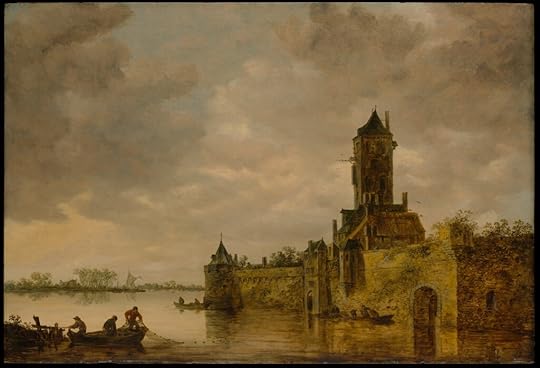 Castle by a River, Oil on Wood,
Jan van Goyen
, 1647, Via
The Met
Castle by a River, Oil on Wood,
Jan van Goyen
, 1647, Via
The Met

Want to stay in touch with me? Sign up for Dead Drop, my rare and elusive newsletter. Subscribers get news, previews, and notices on my books before anyone else delivered directly to their inbox. I work hard to ensure it’s not spammy and contains interesting and relevant information. Sign Up Today →



